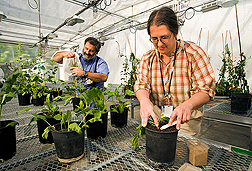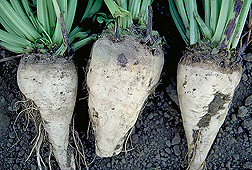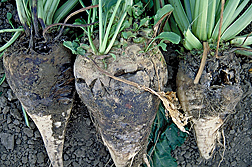Rhizomania
Combating a Sugar Beet Killer
Big, chunky sugar beets play a perhaps surprising role in our everyday lives. This remarkably versatile crop—besides being a source of high-quality sugar—also yields natural chemicals that can be used to make textiles, printer’s ink, and even baker’s yeast for breads and other bakery goods.
And the sugar beet’s luxuriant leafy greens are prized by some home gardeners. Too, this dark-green foliage makes a nutritious feed or feed ingredient for cattle and sheep. So do the byproducts, beet pulp and a slurry called “molasses,” that remain after the beets are sliced, pressed, and processed into sugar.
In addition, this homely, hefty root veggie—a jumbo-sized relative of the common table beet and of Swiss chard—may become an inexpensive, Earth-friendly source of ethanol, helping reduce our dependence on foreign petroleum.
Plethora of Pests Harasses Hapless Sugar Beets
Like many other plants, sugar beets are vulnerable to a passel of pests, including nematodes, bacteria, fungi, and viruses.
For ARS sugar beet scientists, the race to keep ahead of these natural enemies never ends. One example of an ongoing battle pits researchers against a virus responsible for a ruinous disease called “rhizomania,” meaning “root madness.”
|
|
Rhizomania—one of the costliest foes to sugar beet growers worldwide—is the work of a microbe called “beet necrotic yellow vein virus.” The virus moves through soil with the help of a fungal ally known as Polymyxa betae.
The disease causes sugar beets to form small, lateral roots instead of the plump, sugar-rich taproot—the beet—we harvest. Sick plants may also have leaves that are a bright fluorescent yellow, actually a more common symptom than yellowed veins.
Rhizomania was first detected in the United States in 1984. Now it occurs in every region of the country where sugar beets are grown.
When discovered here, rhizomania was quickly held in check by traditional breeding of new sugar beets with natural resistance to the virus. But in 2003, the virus began breaking through that resistance, trouncing sugar beets on some farms in southern California’s Imperial Valley.
ARS plant pathologist Hsing-Yeh Liu, at Salinas, California, was among the first to provide the scientific evidence that the culprit was a new strain, or isolate.
Now, colleagues Robert T. Lewellen, at Salinas, and Leonard W. Panella, at Fort Collins, Colorado, and their co-investigators have new-generation sugar beets that may hold their own against the new rhizomania isolate. The scientists expect to make initial supplies of seed from the resistant beets available to other sugar beet breeders and seed companies later this year. Importantly, some of the new beets also boast significant resistance to Rhizoctonia root rot, the work of a soil-dwelling, decay-causing fungus, Rhizoctonia solani.
Multiple resistance of these new sugar beets is a hallmark of ARS’s plant-breeding ventures. For example, each of the more than three dozen breeding lines of superior sugar beets that Lewellen, Panella, and their colleagues have developed during the past two decades offers moderate or good resistance to at least two sugar beet enemies. These nemeses include Cercospora leaf spot, cyst nematodes, root-knot nematodes, and curly top virus, among others.
Seed companies, processors, and growers have helped fund some of this work.
Finding More Ways To Help
In addition to conventional breeding, scientists are also exploring biological control—using one organism to combat another—and leading-edge tactics of biotechnology to combat sugar beet diseases.
For instance, Panella and Linda E. Hanson, a plant pathologist at Fort Collins, are investigating biological control agents such as a harmless, soil-dwelling fungus called Trichoderma virens. This benign microbe may trigger sugar beet’s natural defenses as it feeds harmlessly on the plant’s roots.
In another line of inquiry, Lewellen and ARS plant pathologist John J. Weiland at Fargo, North Dakota, are using high-tech gene-tagging techniques to search sugar beet’s genetic makeup, or genome.
They are looking for markers, or tags, for genes that help the plant shrug off attack by enemies such as the rhizomania virus, cyst nematodes, or powdery mildew. Breeders can use the tags to more easily select the best plants.
In related experiments, Weiland and plant physiologist Rebecca L. Larson at Fort Collins are exploring the interplay of beet genes and proteins with those of their attackers. Scientists already know that plants like sugar beets are equipped with an intriguing natural defense mechanism called “RNA silencing,” Larson says. Using this defense, sugar beets can degrade, or silence, the rhizomania virus’s RNA, or genetic material.
The result: The virus is much less effective. But the sugar beet’s RNA-silencing response isn’t automatic, Larson explains. So she and Weiland have developed several molecular cues to trigger the silencing defense and are currently evaluating them to see which is most powerful.
Which Proteins Best Protect Beleaguered Beets?
In a separate study, Larson and ARS plant pathologist William M. Wintermantel at Salinas are using a process known as “multidimensional liquid chromatography.” With it, they’re zeroing in on differences among individual proteins produced in roots of resistant and susceptible sugar beets when exposed to the rhizomania virus. The approach offers yet another way to pinpoint sugar beet proteins responsible for rhizomania resistance and, hopefully, the genes behind those valuable proteins. Their discoveries may open the door to new ways to bolster beets’ resistance.
The scientists are posting their findings in a sugar beet genome database on the World Wide Web, making the new information instantly accessible, free of charge, to researchers worldwide.
Each of these studies may lead to a slightly different pest-control strategy. “That’s important,” says Larson, “because growers want several options to choose from.” Those options will ensure that the humble sugar beet remains strongly rooted in our future.—By Marcia Wood and Laura McGinnis, Agricultural Research Service Information Staff.
This research is part of Crop Production, Product Value, and Safety, a group of ARS National Programs described on the World Wide Web at www.nps.ars.usda.gov.
To reach scientists featured in this article, contact Marcia Wood, USDA-ARS Information Staff, 5601 Sunnyside Ave., Beltsville, MD 20705-5129; phone (301) 504-1662, fax (301) 504-1486.
"Rhizomania: Combating a Sugar Beet Killer" was published in the February 2007 issue of Agricultural Research magazine.











